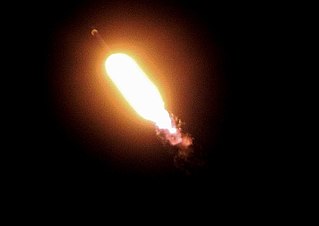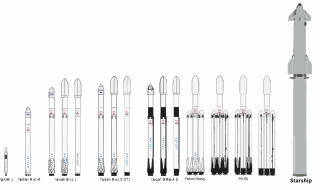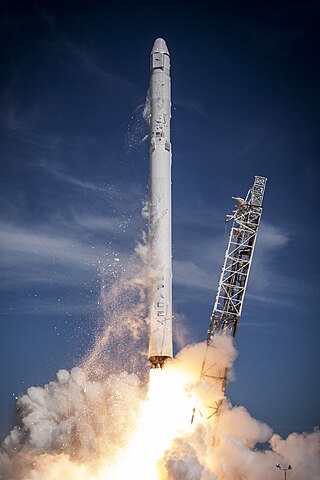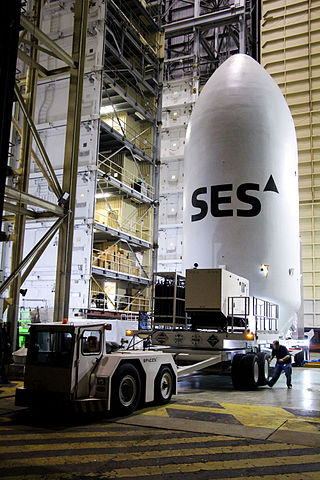
A launch vehicle is typically a rocket-powered vehicle designed to carry a payload from Earth's surface or lower atmosphere to outer space. The most common form is the ballistic missile-shaped multistage rocket, but the term is more general and also encompasses vehicles like the Space Shuttle. Most launch vehicles operate from a launch pad, supported by a launch control center and systems such as vehicle assembly and fueling. Launch vehicles are engineered with advanced aerodynamics and technologies, which contribute to high operating costs.

Falcon 9 is a partially reusable medium-lift launch vehicle that can carry cargo and crew into Earth orbit, designed, manufactured and launched by American aerospace company SpaceX. It can also be used as an expendable heavy-lift launch vehicle. The first Falcon 9 launch was on 4 June 2010. The first Falcon 9 commercial resupply mission to the International Space Station (ISS) launched on 8 October 2012. In 2020 it became the first commercial rocket to launch humans to orbit and remains the only such vehicle. It is the only U.S. rocket certified for transporting humans to the ISS. In 2022, it became the U.S. rocket with the most launches in history and with the best safety record, having suffered just one flight failure.

The Western Range (WR) is the space launch range that supports the major launch head at Vandenberg Space Force Base. Managed by the Space Launch Delta 30, the WR extends from the West Coast of the United States to 90° East longitude in the Indian Ocean where it meets the Eastern Range Operations involve military, government, and commercial interests. The WR has been operated by civilian contractors since its establishment, following the precedent of the Eastern Range. On 1 October 2003, InDyne Inc. took over the range contract from ITT Industries which had operated the range for the previous 44 years.

SES-8 is a geostationary Communications satellite operated by SES S.A. SES-8 was successfully launched on SpaceX Falcon 9 v1.1 on 3 December 2013, 22:41:00 UTC.
Orbcomm is a family of low Earth orbit communications satellites, operated by the United States satellite communications company Orbcomm. As of July 2014, 51 such satellites have orbited Earth, with 50 still continuing to do so.

SpaceX manufactures launch vehicles to operate its launch provider services and to execute its various exploration goals. SpaceX currently manufactures and operates the Falcon 9 Full Thrust family of medium-lift launch vehicles and the Falcon Heavy family of heavy-lift launch vehicles – both of which powered by SpaceX Merlin engines and employing VTVL technologies to reuse the first stage. As of 2023, the company is also developing the fully reusable Starship launch system, which will replace the Falcon 9 and Falcon Heavy.

SpaceX has privately funded the development of orbital launch systems that can be reused many times, similar to the reusability of aircraft. SpaceX has developed technologies over the last decade to facilitate full and rapid reuse of space launch vehicles. The project's long-term objectives include returning a launch vehicle first stage to the launch site within minutes and to return a second stage to the launch pad following orbital realignment with the launch site and atmospheric reentry in up to 24 hours. SpaceX's long term goal would have been reusability of both stages of their orbital launch vehicle, and the first stage would be designed to allow reuse a few hours after return. Development of reusable second stages for Falcon 9 was later abandoned in favor of the development of Starship, however, SpaceX has been developing reusable payload fairings for the Falcon 9.

SpaceX CRS-3, also known as SpX-3, was a Commercial Resupply Service mission to the International Space Station (ISS), contracted to NASA, which was launched on 18 April 2014. It was the fifth flight for SpaceX's uncrewed Dragon cargo spacecraft and the third SpaceX operational mission contracted to NASA under a Commercial Resupply Services (CRS-1) contract.

Falcon 9 flight 10 was a Falcon 9 space launch that occurred on July 14, 2014. It was the fifth launch of the Falcon 9 v1.1 launch vehicle and carried six Orbcomm-OG2 telecommunication satellites. All six 172-kilogram-mass (379 lb) satellites were successfully deployed.

Falcon 9 v1.1 was the second version of SpaceX's Falcon 9 orbital launch vehicle. The rocket was developed in 2011–2013, made its maiden launch in September 2013, and its final flight in January 2016. The Falcon 9 rocket was fully designed, manufactured, and operated by SpaceX. Following the second Commercial Resupply Services (CRS) launch, the initial version Falcon 9 v1.0 was retired from use and replaced by the v1.1 version.

The Falcon 9 v1.0 was the first member of the Falcon 9 launch vehicle family, designed and manufactured by SpaceX in Hawthorne, California. Development of the medium-lift launcher began in 2005, and it first flew on June 4, 2010. The Falcon 9 v1.0 then launched four Dragon cargo spacecraft: one on an orbital test flight, then one demonstration and two operational resupply missions to the International Space Station under a Commercial Resupply Services contract with NASA.

The Falcon 9 first-stage landing tests were a series of controlled-descent flight tests conducted by SpaceX between 2013 and 2016. Since 2017, the first stage of Falcon 9 missions has been routinely landed if the rocket performance allowed it, and if SpaceX chose to recover the stage.

SES-9 is a geostationary communications satellite operated by SES S.A. It was launched from Cape Canaveral SLC-40 by a Falcon 9 Full Thrust launch vehicle on 4 March 2016.

Falcon 9 flight 20 was a Falcon 9 space launch that occurred on 22 December 2015 at 01:29:00 UTC. It was the first time that the first stage of an orbital rocket made a successful return and vertical landing.

Falcon 9 Full Thrust is a partially reusable medium-lift launch vehicle, designed and manufactured by SpaceX. It was first designed in 2014–2015, with its first launch operations in December 2015. As of 24 January 2024, Falcon 9 Full Thrust had performed 272 launches without any failures. Based on the Laplace point estimate of reliability, this rocket is the most reliable orbital launch vehicle currently in operation.
A medium-lift launch vehicle (MLV) is a rocket launch vehicle that is capable of lifting between 2,000 to 20,000 kg by NASA classification or between 5,000 to 20,000 kilograms by Russian classification of payload into low Earth orbit (LEO). An MLV is between small-lift launch vehicles and heavy-lift launch vehicles.

Falcon 9 booster B1058 was a reusable Falcon 9 Block 5 first-stage booster manufactured by SpaceX. B1058 was the first Falcon 9 booster to fly fourteen, fifteen, sixteen, seventeen, eighteen and nineteen times and broke a turnaround record on its later flights. Its first flight was for Crew Dragon Demo-2, the first crewed orbital spaceflight by a private company. The booster was the first and only Falcon 9 booster to feature NASA's worm logo and meatball insignia, which was reintroduced after last being used in 1992. The booster's service ended shortly after its nineteenth successful landing when it toppled over on the droneship due to high winds and rough seas.















